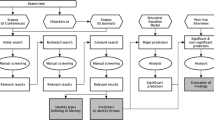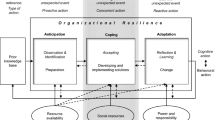Abstract
Like other high hazard sectors, successful crisis response relies on a well-founded understanding of the work domain and the manner in which operators perceive and deal with obstacles to achieving goals. That understanding is essential to the development of information and communications technology (ICT) that are intended to support operator performance. While crises are uncommon in other high hazard sectors such as nuclear power generation and aviation, acute and ambulatory healthcare work encounters life-and-death crises daily. This makes healthcare a useful living laboratory to develop ICT in order to manage crises. This paper shows how healthcare organizations that continually deal with complex, uncertain, high-tempo operations can serve as a model to develop ICT that supports crisis management. We illustrate the results of using these methods through an example of cognitive systems engineering research that identifies ambulatory care risks to patients. We then describe multiple methods that can be used together to efficiently study complex, high hazard work settings. We conclude with an example of how it can support the development of a cognitive aid for diabetic care to support work in that setting.



Similar content being viewed by others
References
Ash J, Berg M, Coiera E (2004) Some unintended consequences of information technology in health care: The nature of patient care information system-related errors. J Am Med Inform Assoc 11(2):104–112
Bryant W, Greenfield JR, Chisholm DJ, Campbell LV (2006) Diabetes guidelines: Easier to preach than to practise? Med J Aust 185(6):301–302
Cramer JA (2004) A systematic review of adherence with medications for diabetes. Diabetes Care 27:1218–1224
Feltovich PJ, Ford KM, Hoffman RR (eds) (1997) Expertise in context: human and machine. MIT Press, Cambridge
Fu L, Salvendy G, Turley L (1998) Who finds what in usability evaluation. In: Proceedings of the human factors and ergonomics society 42nd annual meeting. Human Factors and Ergonomics Society, Santa Monica pp 1341–1345
Guerci B, Drouin P, Grangé V, Bougnères P, Fontaine P, Kerlan V, Passa P, Thivolet CH, Vialettes B, Charbonnel B (2003) Self-monitoring of blood glucose significantly improves metabolic control in patients with type 2 diabetes mellitus: the Auto-Surveillance Intervention Active (ASIA) study. Diabetes Metab 29(6):587–594
Hoffmann R, Crandall B, Shadbolt N (1998) Use of the critical decision method to elicit expert knowledge: a case study in cognitive task analysis methodology. Hum Factors 40(2):254–276
Hollnagel E, Woods D, Leveson N (eds) (2006) Resilience engineering: concepts and precepts. Ashgate Publishing, Aldershot
Hollnagel E, Nemeth C, Dekker S (eds) (2008) Remaining sensitive to the possibility of failure. Resilience engineering perspectives. 1. Ashgate Publishing, Aldershot
Hutchins E (2002) Cognitive artifacts. Retrieved on 7 July 2002 from the MIT COGNET Web Site: http://cognet.mit.edu/MITECS/Entry/hutchins
Klein H (2008) Adaptation at the edge: when the system is complex, the stakes high, and the operator novice. In: Nemeth C, Symposium on adaptation to change and uncertainty. Human Factors and Ergonomics Society annual meeting, New York
Klein G, Calderwood R, MacGregor D (1989) Critical decision method for eliciting knowledge. IEEE Trans Sys Man Cybern 19(3):462–472
Klein G, Woods DD, Bradshaw JM, Hoffman RR, Feltovich PJ (2004) Ten challenges for making automation a “team player” in joint human-agent activity. IEEE Computer 6:91–95
Konen JC, Curtis LG, Summerson JH (1996) Symptoms and complications of adult diabetic patients in a family practice. Arch Fam Med 5(3):135–145
Morisky DE, Kominski GF, Afifi AA, and Kotlerman JB (2008) The Effects of a disease management program on self-reported health behaviors and health outcomes: evidence From the “Florida: a healthy state (FAHS)” medicaid program. Health Educ Behav Online
Nemeth C (2003) The master schedule: how cognitive artifacts affect distributed cognition in acute care. Dissertation Abstracts International 64/08, 3990, (UMI No. AAT 3101124)
Nemeth C (2004) Human factors methods for design. Taylor and Francis/CRC Press, Boca Raton
Nemeth C (2007) Healthcare groups at work: Further lessons from research into large scale coordination. In: Nemeth C (ed) Second special issue on large scale coordination. Cogn Technol Work 9(3):127–130
Nemeth C, Klein G (2011) The naturalistic decision making perspective. In: Cochran JJ (ed). Wiley encyclopedia of operations research and management science. John Wiley and Sons, New York
Nemeth C, Wears R (2008) An agenda for healthcare team communication research. In: Nemeth C (ed) Improving healthcare team communication: building on lessons from aviation and aerospace. Ashgate Publishing, Aldershot, pp 245–250
Nemeth C, Cook R, Woods D (2004) The messy details: insights from technical work in healthcare. In: Nemeth C, Cook R, Woods D (eds). Special issue on studies in healthcare technical work. IEEE Trans syst Man and Cybern-part A. 34:6 pp 689–992
Nemeth C, O’Connor M, Klock PA, and Cook RI (2006) Discovering healthcare cognition: the use of cognitive artifacts to reveal cognitive work. In: Lipshitz R (ed) Special issue on naturalistic decision making. Organ Stud 27(7):1011–1035
Nemeth C, Walter J, Wears R, Cook RI (2008a) The path to resilience in ambulatory care. Agency for healthcare research and quality annual meeting, Bethesda, MD
Nemeth C, Wears R, Woods D, Hollnagel E, and Cook R (2008b) Minding the gaps: creating resilience in healthcare. In: Henriksen K, Battles JB, Keyes MA, Grady ML (eds) Advances in patient safety: new directions and alternative approaches. 3. Performance and tools. AHRQ publication no. 08-0034-3. Rockville, MD: agency for healthcare research and quality. pp 259–271
Newell A, Simon HA (1972) Human problem solving. Prentice Hall, Englewood Cliffs
Nielsen J, Mack RL (1994) Usability inspection methods. Wiley, New York
Norris S, Lau J, Smith S, Schmid C, Engelgau M (2002) Self-management education for adults with Type 2 diabetes: a meta-analysis of the effect on glycemic control. Diabetes Care 25(7):1159–1172
Patterson E, Cook R, Woods D, Render M Gaps and resilience. In: Bogner M (ed) Human error in medicine. 2nd edn. Lawrence Erlbaum, Hillsdale, NJ (in press)
Patton M (2002) Qualitative research and evaluation methods, 3rd edn. Sage Publications, Thousand Oaks
Perry S, Wears R (2009) Notes from the underground. In: Nemeth C, Hollnagel E, Dekker S (eds) Resilience engineering perspectives, volume 2: preparation and restoration. Ashgate Publishing, Aldershot
Potter S, Roth E, Woods D, Elm C (1998) Bootstrapping multiple converging cognitive analysis techniques for system design. In: Van Schraagen JM, Chipman F, Schalin V (eds) Cogntive task analysis. Lawrence Erlbaum, Hillsdale
Rasmussen J, Pjetersen AM, Goodstein LP (1994) Cognitive systems engineering. Wiley, New York
Reid PR, Compton WD, Grossman JH, Fanjiang G (eds) (2005) Building a better delivery system: a new engineering/health care partnership. The National Academies Press, Washington
Rubin J (1994) Handbook of usability testing. Wiley, New York
Thompson LK, Hickson JCL, Burns CM (2003) A work domain analysis for diabetes management. Human Factors and Ergonomics Society Annual Meeting. Denver. pp 1516–1520
Vicente K (2000) Work domain analysis and task analysis: a difference that matters. In: Schragen JM, Chipman SF, Shalin VL (eds) Cognitive task analysis. Lawrence Erlbaum Associates, Mahwah, pp 101–118
Wears R, Perry S, Anders S, Woods D (2008) Resilience in the emergency department. In: Hollnagel E, Nemeth C, Dekker S (eds) Resilience engineering perspectives 1. Remaining sensitive to the possibility of failure. Ashgate Publishing, Aldershot, pp 193–210
Weick KE (2001) Tool retention and fatalities in wildland fire settings: conceptualizing the naturalistic. In: Salas, E, Klein G (eds) Linking expertise and naturalistic decision making. Lawrence Erlbaum Associates, Mahwah, New Jersey, pp 321–336
Weyhreter H, Holl RW, Beerstecher AM, Borsch M (2008) Additional treatment supporting standard care for children and adolescents with diabetes mellitus Type I—indication, acceptance and outcome: results from a multi-centre observational study. Klin Padiatr 220(2):70–76
Woods DD (2003) Process tracing methods for the study of cognition outside the experimental psychology laboratory. In: Klein G, Calderwood R, Orasanu J (eds) Decision making in action: models and methods. Ablex, Norwood, pp 228–251
Woods D, Cook RI (2002) Nine steps to move forward from error. Cogn Technol Work 4(2):137–144
Acknowledgments
The authors gratefully acknowledge insightful contributions by James Walter, MD during the research that formed the basis for this manuscript. Dr. Nemeth’s research during his tenure at the University of Chicago was made possible by generous support of the University of Chicago’s Department of Anesthesia and Critical Care, and a grant from the Agency for Healthcare Research and Quality.
Author information
Authors and Affiliations
Corresponding author
Rights and permissions
About this article
Cite this article
Nemeth, C., Wears, R.L., Patel, S. et al. Resilience is not control: healthcare, crisis management, and ICT. Cogn Tech Work 13, 189–202 (2011). https://doi.org/10.1007/s10111-011-0174-7
Received:
Accepted:
Published:
Issue Date:
DOI: https://doi.org/10.1007/s10111-011-0174-7




